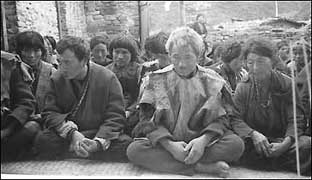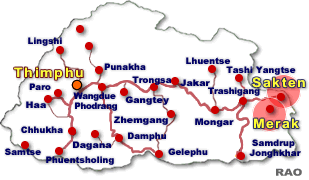|
Bhutan
- Ethnic Groups & People
|
 |
Bhutan's People Merak - Sakten |
|
 |
Bhutan Information |
|
|
 |
 |
|
The
seasonal migration
|
 |

 |
| The people of Khaling and Brekha in Trashigang say that the Brokpas of Merak
and their livestock are encroching on their pasturelands.
For three
winters in a row, 40- year old farmer of Merak, Trashigang, had been facing
the same problem: not enough feed for his 400 or so sheep. The grazing
land for his cattle and sheep in the lower areas, he said, was diminishing. |
|
The
seasonal migration of the semi-nomads of Merak, commonly known as Brokpas
in the east, have come in conflict with the residents of Khaling over grazing
rights in the periphery of Khaling and Brekha.
 |
The
conflict, according to the residents of Brekha and Khaling, started as
the number of Brokpas and their livestock population entering their forests
increased every winter. Apart from posing a threat to their crops, cattle
grazing had caused economic and environment related problems in the area.
"Cattle holding and family fragmentation have increased the number of Brokpas
in the region competing for the little grazing land available and endangering
forest resource and water sources in the catchment areas," the Khaling
chimi told. |
"Each
family owns about a hundred heads of cattle and sheep," he added. "And
the number continues to rise."
According
to the chimi, an agreement signed between the Brokpas and the resident
of Khaling in 1979 allowed 18 households from Merak to graze their livestock
on the Tsamdo or grazing land in Khaling. But, over the years, not only
the number of cattle and sheep but the population of Brokpas had increased.
Some
Brokpas stayed in the Khaling/ Brekha area throughout the year. "Without
any compliance to the genja (agreement), about 40 percent of the Brokpa
cattle and sheep stay back even during summer posing extra burden to the
private grasslands," the chimi said.
The
recent establishment of a community forest has added to the problem. The
Joenshamlamdoksa Community Forest in Khaling was once the grazing area
for the Brokpas and the local community. But the local community surrendered
their grazing rights opting for a community forest. The restriction had
pressured the Brokpas to look for alternatives. According to ranger
Dorji Dukpa the Joenshamlamdoksa area had to be protected because a flash
flood there in 2000 was mainly caused by exces-sive grazing in the catchments.
"The
conflict between the Brokpas and the local community was there from the
inception of the forestry rules," a divisional forest officer in Trashigang
said. Many areas in the east are overgrazed causing various environmental
threats. Khaling, Phongmey, Shongphu and Radhi are the worst affected by
overgrazing. The interest of both Brokpas and the local community have
to be respected and it is very difficult to discourage the Brokpas from
practising this ageold tradition. Moreover, the Khaling-Kharungla area
involved three dungkhags which further complicated the issue.
According
to a study carried out by a forest official, apart from cutting vast stretches
of bamboos Brokpas are involved in both lopping (a method of cutting branches
for fodder) and griddling (felling trees to let grasses grow) of trees.
Although the latter has been stopped completely lopping is still widely
practiced.
top
An
average Brokpa family owns about 40 to 50 heads of cattle and sheep which,
according to forest officials, are beyond the carrying capacity of the
grazing lands. According to the 1986 Animal Husbandry Pasture draft, a
single cow needs about two hectares of grazing land for a duration of one
year.
But in Kharungla alone, there are about 8,000 cattle in the 7000-hectare
forest. Because of the conflict between the local community and the Brokpas,
social forestry components in the Kharungla forest management unit could
not be carried out. "If not protected, these areas would face the same
problem which Chopheling and Mindula in the north faced," a forest officer
said. Chopheling and Mindula were the two worst areas affected by landslides
and forest degradation in the north of Trashigang.
But
the Brokpas with very little knowledge of environment are not deterred.
"Our migration is a way of our life, we have been practicing this for generations,"
a local said. He added that the Brokpas do not have any alternative for
livelihood. However, efforts are underway to make the Brokpas understand
the pressure they exert on the environment. Forest officials have suggested
rotation grazing, while some areas have been identified for pasture management.
Unlike the Layaps in the west who descend in the lower valleys to barter
their goods with food grains, the Brokpas had been bringing their cattle
and sheep to the warmer south for years. Escaping from the harsh weather
and driven by economic ne-cessity, they stay in these areas from the onset
of winter till March or April.

|
| Contributed
by KUENSEL, Bhutan's National Newspaper |
| more
information |
 |
|




